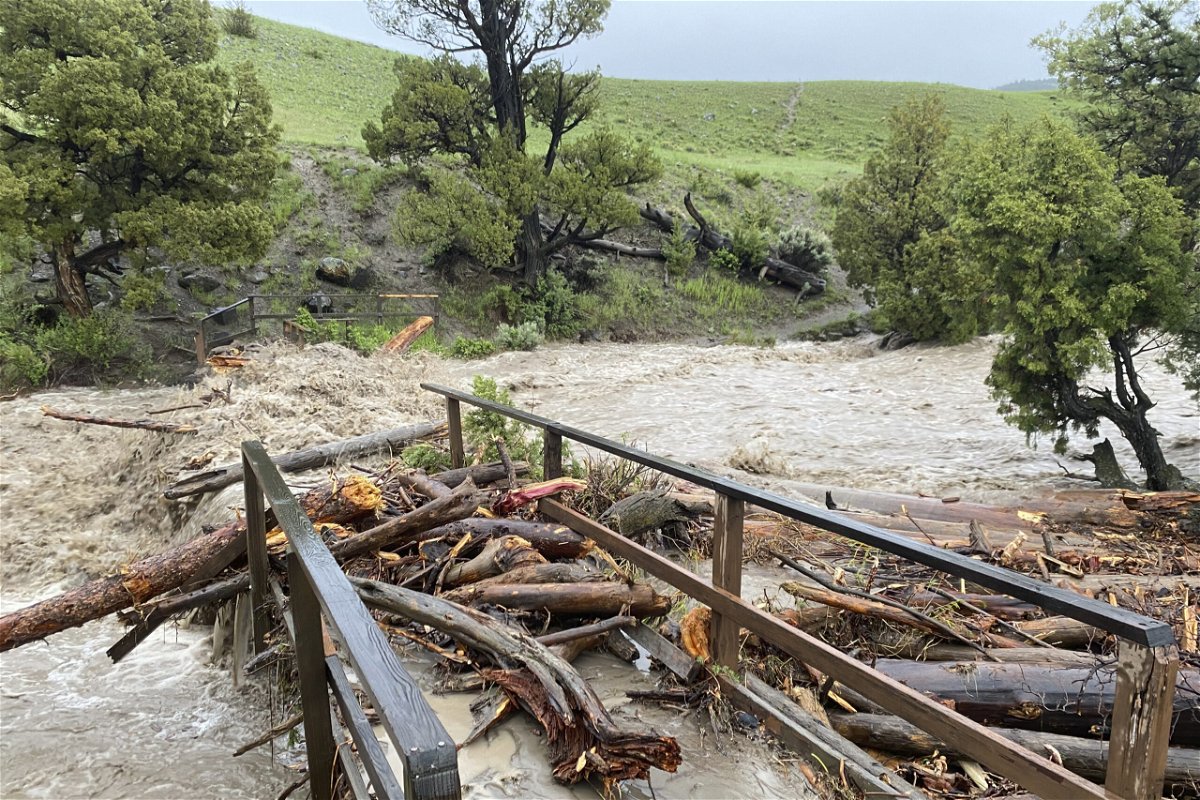Parts of Yellowstone National Park may stay closed for ‘substantial length of time’ after severe flooding

By Jason Hanna, Amir Vera, Elizabeth Wolfe, David Williams and Paradise Afshar, CNN
While all entrances of Yellowstone National Park are temporarily closed because flooding has damaged roads and bridges, the park’s northern portion in particular may remain closed for “a substantial length of time,” park officials said Tuesday.
“Many sections of road in (the park’s northern areas) are completely gone and will require substantial time and effort to reconstruct,” a news release reads. ” … It is probable that road sections in northern Yellowstone will not reopen this season due to the time required for repairs.”
Dangerous flooding caused by abundant rain and rapid snowmelt began to hit the park and several counties in southern Montana on Monday, washing out or eroding roads and bridges and inflicting widespread damage on homes and businesses.
The park on Monday closed all five of Yellowstone’s entrances in Montana and Wyoming to inbound traffic — in part to prevent people from being stranded as conditions deteriorated.
Yellowstone National Park could partly reopen as early as Monday, the Casper Star Tribune reports. Cam Sholly, the park’s superintendent, told residents and tourists in Cody on Wednesday rangers could reopen parts of the park not badly impacted by flooding, according to the paper.
Park officials told visitors already in the park to leave, and more than 10,000 have left the park since Monday, Sholly said Tuesday.
Though cooler temperatures and drier weather have allowed some parts of swollen rivers to start receding, higher temperatures are expected later this week and into the weekend, which could cause more snowmelt runoff and therefore more flooding, CNN meteorologist Brandon Miller said.
“There will be no inbound visitor traffic at any of the five entrances into the park, including visitors with lodging and camping reservations, until conditions improve and park infrastructure is evaluated,” the park’s release reads.
Quickly deteriorating road conditions in Yellowstone created harrowing evacuations for some visitors, including the parents of CNN supervising producer Tim Carter, who had to exit over a bridge which had been compromised.
“When we were going over it, it was really scary because the water was already violently swirling around the bridge,” Martha Carter said. “We did find out later that it had washed out.”
Meanwhile, some surrounding communities in Montana were left without power or safe drinking water as flood conditions made it impossible or unsafe to travel and compromised water supplies.
Montana Gov. Greg Gianforte declared a statewide disaster Tuesday and announced he would seek an expedited presidential disaster declaration to help cover the cost of recovery.
The dangerous flooding is just one of several extreme weather events bearing down on communities across the US, including a blistering heat wave affecting more than 100 million people, and severe storms knocking out power for hundreds of thousands in the Midwest and Ohio River Valley.
Dramatic flooding prompts evacuations and rescues
Rain and snowmelt flooded rivers including the Yellowstone River, which runs northwest through Yellowstone Park in Wyoming and then north and eastward through several nearby Montana communities.
The flooding washed out parts of roads especially in the northern part of the park, and inundated south Montana homes, businesses and infrastructure Monday, forcing many families to evacuate. In the Montana city of Gardiner, a gateway to the park’s northern entrance, video from witnesses showed a building collapsing into the Yellowstone River on Monday.
In Montana’s Park County, which includes Gardiner, at least two homes collapsed into the intruding river and numerous homes and businesses were flooded, Greg Coleman, the county’s disaster emergency services manager, told CNN Wednesday.
For some, roads and bridges were rendered temporarily impassable by the flooding, leaving them trapped, at times without clean water or power.
The Montana National Guard used four helicopters to help with evacuations in affected areas on Monday and Tuesday and also sent soldiers to the city of Red Lodge to establish a command center for search and rescue efforts, the force said. The Guard has used helicopters to rescue 87 people in south-central Montana since Monday, it said Wednesday.
A Montana helicopter company flew about 40 people out of Gardiner, which was temporarily isolated by flooding, Laura Jones with Rocky Mountain Rotors told CNN.
In the south Montana community of Absarokee, situated along a Yellowstone River tributary, resident Tracy Planichek and her husband had just reached their long-awaited goal of having a new home when the flood threat forced them to evacuate.
Now, she told CNN, she is desperately hoping it has avoided the destruction seen in other homes, some of which were swept away. “(We’ve) never been able to afford a new house,” she said. “It’s sitting at the top of the lane, and we’re hoping that by some God miracle that our house will be there.”
A road from Livingston into Gardiner was reopened Tuesday to local traffic, goods and services, but “significant damage” remains, Park County Sheriff Brad Bichler said.
Floods shut down businesses in Gardiner
The flooding in Yellowstone has also had an adverse effect on businesses in the area.
Tami Rai McDonald owns the historic Park Hotel Yellowstone in Gardiner and told CNN Wednesday she and her staff are “at the end of a rope” because the flooding and closing of Yellowstone Park has “cut us off from the world.”
The Park Hotel is usually booked one to two years in advance, McDonald said.
“This closure of entrance during high season has caught all by surprise with no back up plans to survive what supports our livelihood,” McDonald told CNN via text message, adding many visitors have called and emailed they were looking forward to staying at her hotel and have no alternative plans.
“So we (are) empty now, employees planned their lives to be here to keep things special, they feel a bit lifeless, abandoned, we feel sick for our guests who so looked forward to their time here, to get away, so excited,” McDonald’s text read. “So many guests are so upset, crying, don’t know what to do.”
Kari Huesing, who works at the Yellowstone Gateway Inn, told CNN the area has been a ghost town this week. One hotel, she said, shut down and sent all of their employees home. Her hotel will have a meeting to decide what they can do going forward.
“This is all based on tourism,” Huesing said. The Yellowstone Gateway Inn had been booked for a year, Huesing said, and now there is all but one person at the hotel who actually recently checked out.
Flood wave moves to Billings and further east
A wave of flooding still was moving east Wednesday along the Yellowstone River, threatening more trouble in south Montana.
By early Wednesday, major flooding from the river was being reported in Billings, roughly a 175-mile drive east of Gardiner. The river in Billings rose above its previous record, 15 feet, around 4 p.m. Tuesday, said the National Weather Service.
“Exactly how high the river is, is a bit unsure with floodwaters impacting the gauge a bit at these higher levels, but have not seen a downturn trend yet,” the service’s office in Billings tweeted early Wednesday.
Fields and streets were flooded along the river Tuesday just outside Billings, images posted to Facebook by the Yellowstone County Sheriff’s Office showed. One picture showed two people walking in calf-deep water in a neighborhood.
Billings public works officials said they decided Tuesday night to shut down water plant facilities after flooding in the Yellowstone River caused river levels to exceed 16 feet, according to a Facebook post from the department.
“As of Wednesday at 8:30 a.m., the water level at the plant reached more than 16 feet. For the plant to operate effectively, the river needs to be at 15 feet or below,” officials said in the post.
Public works director Debi Meling said Wednesday no one had planned for this level of flooding the facilities were designed and recognized the diligence of the facilities’ operational teams.
She added the plant would not return to “normal operations” until river water levels decrease.
Meling said all reservoirs are filled, and the plant would have water for the community for about a day to a day and a half. Superintendent of Parks Mike Pigg said firetrucks were filled with water and water for all city parks was turned off.
The river should crest there Wednesday — though attention will turn to high temperatures that could cause more snowmelt and more flooding in the region this weekend.
Billings will approach record temperatures in the upper 90s Friday and Saturday, while the higher elevations will be in the 60s and 70s. This would be warm enough to melt the remaining snow pack and lead to additional river rises over the weekend. And more rain is possible in the area on Sunday.
A lot of rain and snowmelt in only three days
What led to the flooding was substantial rainfall and snow runoff over the weekend in the Beartooth and Absaroka mountain ranges, which span the Montana-Wyoming state line.
The combination of rain and snowmelt created a “total water event of at least 4 to 9 inches,” the National Weather Service in Billings said Tuesday.
That amount of runoff is similar to the region receiving two to three times a normal June’s precipitation in only three days, according to CNN meteorologists.
In the park, officials had all visitors move out of lodging and campgrounds and leave the park to prevent anyone from being stranded, the National Park Service said in a news release. The park averages between 15,000 and 20,000 visitors in June, Sholly said.
The park has also closed the Yellowstone back country and has been in contact with groups in the area.
“We have contacted or know the whereabouts of every back country user currently in Yellowstone,” Sholly said, noting one group remained in the northern range. No helicopter evacuations have been necessary, he said.
No known injuries or deaths occurred in the park because of the flooding, Sholly said, and officials do not believe the animals in the park have been significantly affected.
The park’s southern loop “appears to be less impacted than the northern roads” and teams will try to determine when the loop can be reopened. But officials expect it to stay closed at least through Sunday, the park’s release states.
The-CNN-Wire
™ & © 2022 Cable News Network, Inc., a WarnerMedia Company. All rights reserved.
CNN’s Amanda Jackson, Judson Jones, Caroll Alvarado and Claudia Dominguez contributed to this report.




